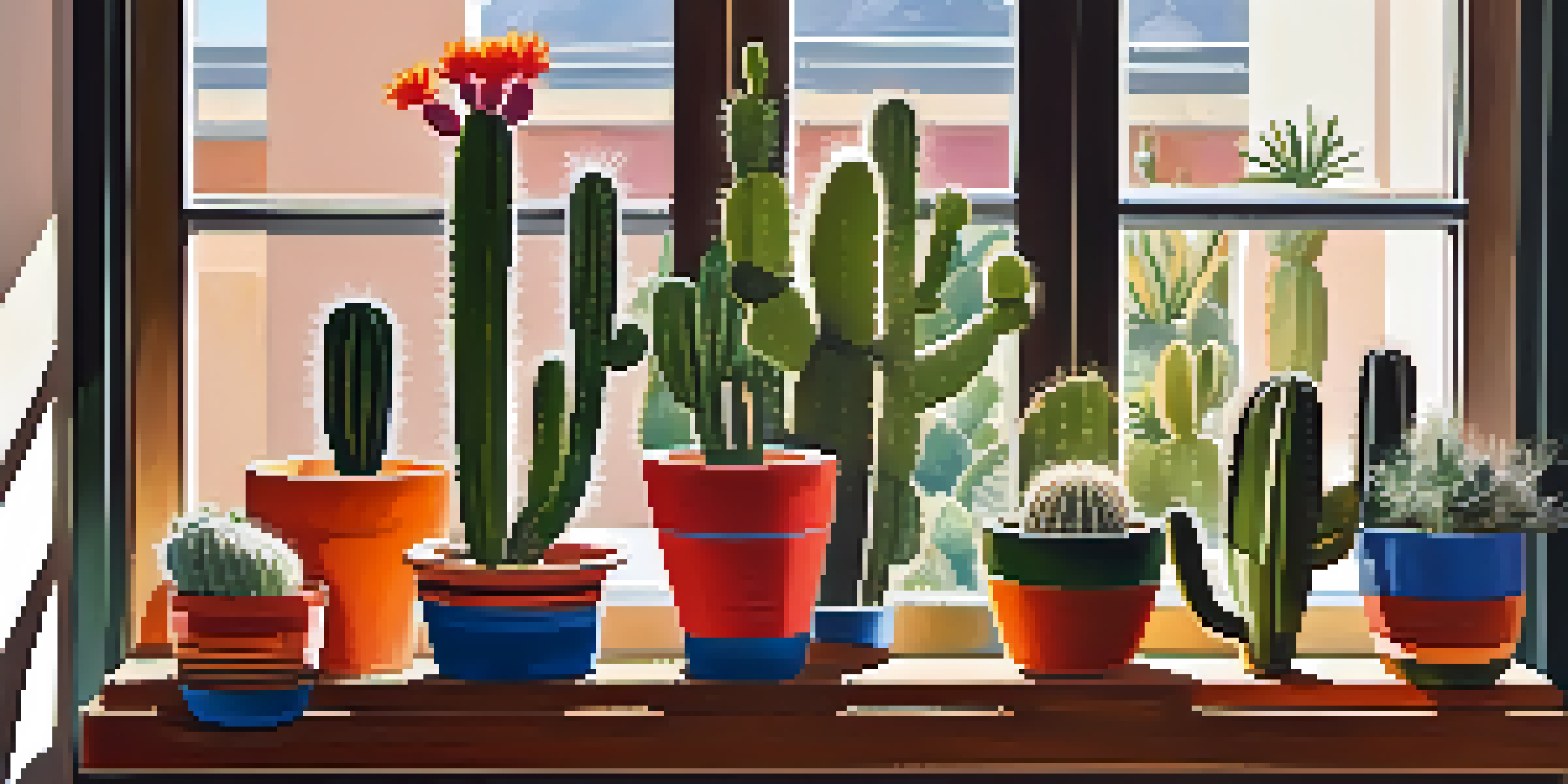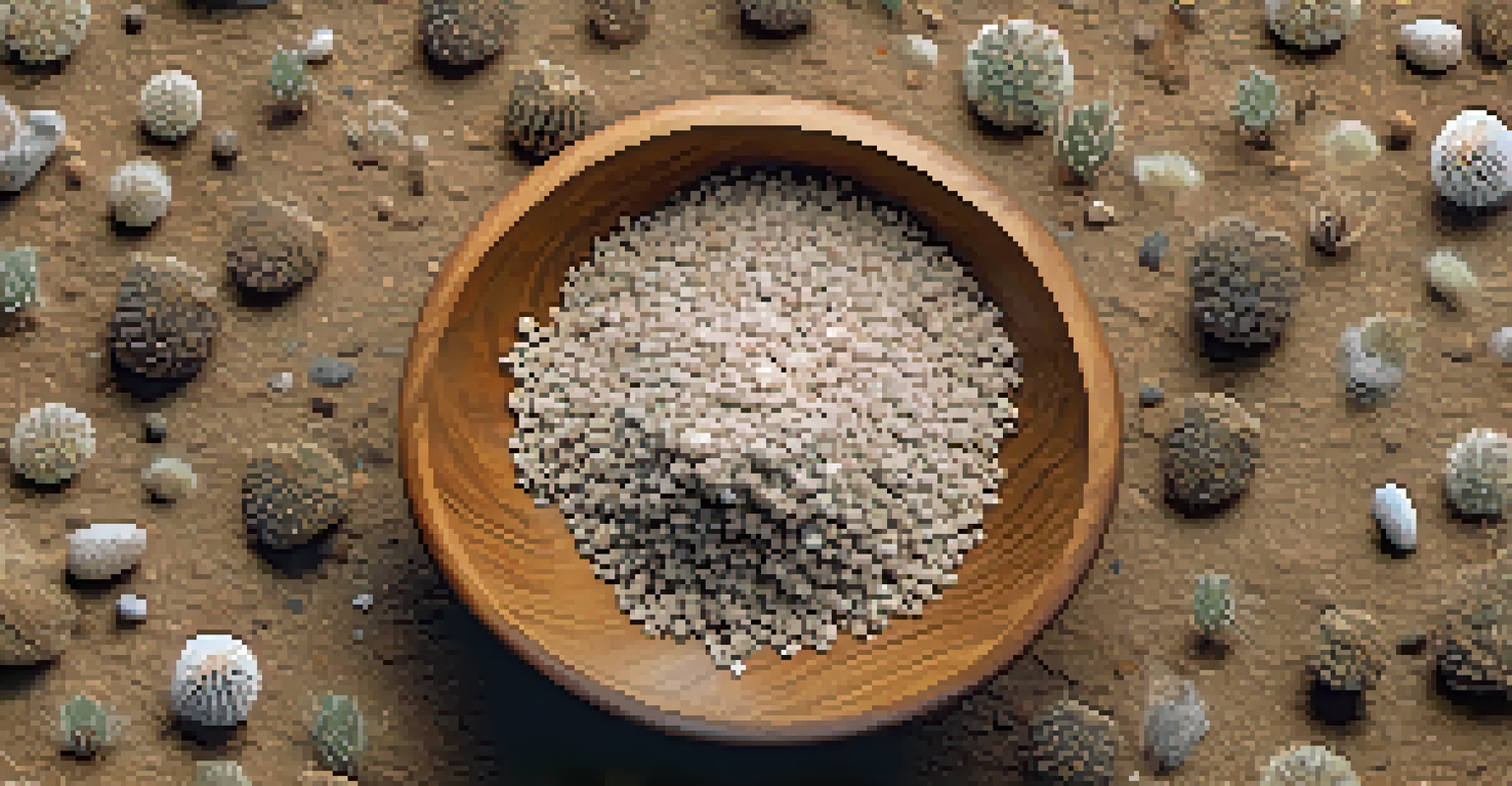The Importance of Soil for Cacti: Choosing the Right Mix

Why Soil Quality Matters for Cacti Health
Soil quality is crucial for the overall health of your cacti. Unlike many plants, cacti thrive in dry, well-draining environments. Poor soil can lead to root rot and other issues, making it essential to choose the right mix for your spiky friends.
The health of your plants is directly related to the quality of the soil they grow in.
Cacti have evolved to survive in arid conditions, which means they require specific nutrients and soil structure. A good mix allows for proper aeration and drainage, ensuring that water doesn’t linger around the roots. This is vital because too much moisture can be detrimental to their health.
Additionally, the right soil can help support the natural growth habits of cacti. Healthy soil promotes better nutrient absorption, enhancing the plant's ability to thrive and flourish. In short, investing in quality soil is investing in the longevity of your cacti.
Key Characteristics of Cactus Soil
Cactus soil should have three main characteristics: excellent drainage, aeration, and a light texture. These features help mimic the arid habitats that cacti are accustomed to. A heavy or compact soil mix can suffocate roots and lead to decay, so it's important to choose wisely.

Typically, a cactus soil mix will include components like sand, perlite, and potting soil. Sand and perlite provide excellent drainage and help prevent water retention, which is exactly what cacti need. By mixing these elements, you create an ideal environment for your plant to thrive.
Soil Quality is Key for Cacti
Choosing the right soil mix ensures proper drainage and aeration, crucial for preventing root rot and promoting cactus health.
Furthermore, a good cactus mix often includes organic matter, which provides essential nutrients. While cacti don’t require as much nourishment as other plants, they still benefit from a little extra care. This balance of drainage and nutrients is key to a healthy cactus.
Choosing Between Commercial and DIY Soil Mixes
When it comes to cactus soil, you have two main options: buy a pre-made mix or create your own. Commercial mixes can be convenient and often come tailored for cacti, saving you time and effort. However, they can vary widely in quality, so it’s essential to read labels carefully.
Good soil is the foundation of a healthy garden, and cacti are no exception.
On the other hand, making your own soil mix can be quite rewarding. You can customize the ingredients to suit your specific cacti needs and preferences. A simple blend of potting soil, sand, and perlite can work wonders and ensure your cacti get exactly what they require.
Ultimately, the choice between commercial and DIY depends on your comfort level and the specific needs of your plants. Both approaches can lead to happy, healthy cacti if you pay attention to the soil's properties.
Essential Ingredients for a Cactus Soil Mix
When crafting your cactus soil mix, consider including coarse sand, perlite, pumice, and organic matter. Each of these ingredients plays a vital role in creating the right environment for your cacti. For instance, coarse sand helps with drainage, while perlite enhances aeration.
Pumice is another great option that can improve drainage while retaining some moisture, which can be beneficial during hotter months. Organic matter, such as compost, provides nutrients but should be used sparingly to avoid over-fertilization.
DIY or Commercial Soil Options
Both commercial and DIY soil mixes can support healthy cacti, but understanding their specific needs is essential for success.
By combining these ingredients in the right proportions, you can create a customized mix that meets your cacti's unique needs. This tailored approach can significantly improve their health and growth over time.
Understanding pH Levels for Cacti Soil
pH levels are an important factor to consider when selecting soil for your cacti. Most cacti prefer a slightly acidic to neutral pH, typically between 5.5 and 7.0. This range allows for optimal nutrient absorption, which is essential for healthy growth.
Testing your soil's pH can be done with easy-to-use kits available at garden centers. If your soil is too acidic or alkaline, you can adjust it by adding lime to raise the pH or sulfur to lower it. Maintaining the right pH balance can promote robust growth and vibrant blooms.
By keeping an eye on pH levels, you can ensure that your cacti are receiving the nutrients they need. This small step can make a big difference in the overall health and appearance of your plants.
Watering Practices for Cacti in the Right Soil
Even with the perfect soil mix, understanding how to water your cacti is crucial. Cacti thrive on a watering schedule that mimics their natural environment, which often means infrequent watering. Overwatering can easily lead to root rot, especially in poorly draining soils.
When watering, always allow the soil to dry out completely between sessions. This practice helps prevent excess moisture from accumulating around the roots, keeping them safe and healthy. A good rule of thumb is to water when the top inch of soil feels dry to the touch.
Avoiding Common Soil Mistakes
Using regular potting soil or neglecting drainage can harm your cacti, so it's important to customize and monitor their growing conditions.
Additionally, consider the season when determining your watering routine. During the growing season (spring and summer), cacti may need more frequent watering, whereas, in the dormant winter months, they require much less. Tailoring your watering practices to the season will optimize your cacti's health.
Common Mistakes to Avoid with Cactus Soil
There are a few common mistakes that many cactus owners make when it comes to soil. One of the biggest missteps is using regular potting soil without modifications. This type of soil retains too much moisture, which can lead to root problems for cacti.
Another mistake is not paying attention to drainage holes in pots. Even the best soil mix can’t save your cactus if the pot doesn’t allow excess water to escape. Ensuring your pot has proper drainage is crucial to maintaining a healthy growing environment.

Lastly, be cautious with fertilizers. While cacti do need some nutrients, over-fertilizing can burn their roots. Using a diluted, balanced fertilizer during the growing season can provide the right boost without overwhelming your plants.